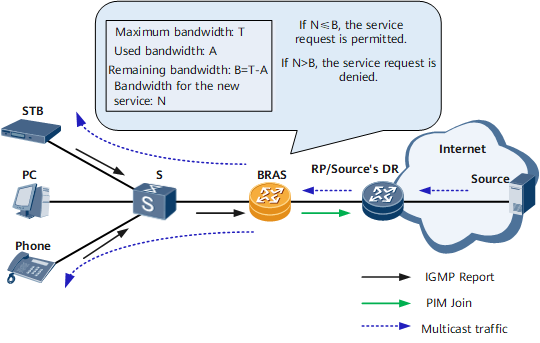User-side Multicast CAC
Overview
User-side call admission control (CAC) is a bandwidth management and control method used to guarantee multicast service quality of online users.
A conventional quality-guarantee mechanism is to limit the maximum number of multicast groups that users can join. With this mechanism, a BRAS checks whether the maximum number of multicast groups has been exceeded after receiving a Join message from a user. If the maximum number has been exceeded, the device drops the Join message and denies the user request. This mechanism alone, however, has become incompetent due to the continuous increase of IPTV program varieties. A high upper limit may prevent the device from denying many join requests but cannot prevent the device from dropping messages due to limited bandwidth resources on interfaces.
User-side multicast CAC addresses these issues by enabling a BRAS to limit bandwidth for users.
User-side multicast CAC enables a BRAS to check the bandwidth limit and deny user requests if the limit has been exceeded.
User-level bandwidth limit: A bandwidth limit can be set for each user in a specific user access domain, and new service requests of a user are denied when the bandwidth consumed by the user exceeds the bandwidth limit.
Interface-level bandwidth limit: A bandwidth limit can be set for a user access interface, and new service requests are denied when the consumed bandwidth exceeds the bandwidth limit.

User-side multicast CAC supports GE interfaces only.
Principles
Figure 1 shows the working principles of user-side multicast CAC in a process of going online.
The STB and phone users go online.
The STB and phone users send IGMP Report messages to request for multicast services.
The BRAS receives the IGMP Report messages and checks the bandwidth limits configured for the user access domain and interface.
If the remaining bandwidth resources are sufficient for the users:
The BRAS sends a PIM Join message to the RP or source's DR. The RP or source's DR creates a multicast forwarding entry, and sends the service flow received from the source to the BRAS. The BRAS forwards the flow to the users based on the multicast forwarding entry and multicast traffic replication mode (this example uses the by session mode).
If the remaining bandwidth resources are insufficient for the users, the BRAS discards the IGMP Report message and denies the service requests.

The BRAS supports only IPv4 user-side multicast CAC.
User-side multicast CAC supports only PPPoE and IPoE access modes for Layer 2 common users.
The BRAS supports four multicast traffic replication modes: by session, by interface + VLAN, by multicast VLAN, and by interface.
Purpose
Limiting the maximum number of multicast groups cannot guarantee service quality any more due to the increase of IPTV service varieties and the big bandwidth requirement difference among multicast channels. Therefore, user-side multicast CAC was introduced to prevent bandwidth resources from being exhausted, thus guaranteeing the IPTV service quality of online users.
Benefits
User-side multicast CAC brings the following benefits:
Guarantees IPTV service quality for online users.
Allows the denial of new users when a mass of multicast channels are requested and bandwidth resources are insufficient.
